Poker is a game of deep strategy that involves value betting, protection betting, block betting, and bluffing. Out of all, bluffing is the one that will give you the biggest rush of adrenaline. Did you every try bluffing in a live game when your draw missed, and your river bet was the size of 200 big blinds? This can happen in live games and sometimes in online games as well. However, if you are on the other end of the hand, it’s essential to know if your opponent is bluffing or not.

You can risk calling light and look like the dumbass when an opponent has the nuts. Other times you might make a big lay down, and he makes a smirk and flashes you the bluff, only to tilt you.
I admit it, even I, with more than 10 years of poker experience and more than 5 million hands played can get into tilt sometimes when I make a hero call only to see the nuts. Other times you make a correct decision and still lose. Making a correct decision doesn’t mean you are right all the time. You only need to be right often enough to make money with your call.
So how to tell if someone is bluffing in online poker? Many factors determine if someone is bluffing in online poker. Some of these factors are a lot different than in live games. In online games, you can have detailed notes on the opponent, together with the HUD stats.
Most important factors to consider, to tell, if the opponent is bluffing in online poker, are:
- How dry or draw heavy is the board
- Bet sizing
- How fast does opponent bet/act
- Does the board hit opponents range
- How aggressive is the opponent
- How loose is the opponent
- Frequency of bets
- How bad is the board for your range
- Stack size
- A high board
- Did the opponent lose a big a few hands earlier (is opponent tilting)
All of this information bundled together help you make a correct decision, which is sometimes easier and sometimes harder than in live games.
In live games, you can get a lot out of the player by keeping close attention at his body and face gestures. Many live poker players wear hoodies to disguise as much visible skin as possible, so they are harder to read. In online games, you don’t need to worry about any of these. This makes bluffing online somewhat easier.
Although on the other hand, in online games, you have access to many helpful third-party programs that make your decision to make the call or fold easier. You don’t need to be the best body reader to be able to tell if the opponent has a strong hand or not. All you need to have is enough information on the opponent, to determine if he is likely to bluff.
What Does Bluffing Mean in Poker?
Everyone has heard the term to bluff in poker. But that is the exact definition of it? By the definition on Wikipedia, bluffing means to make a bet or a raise with a hand that you believe is no the best hand. The objective of this action is to achieve a fold by the opponent who you think holds a better hand.
Factors to consider to tell if someone is bluffing in online poker
Some of the factors we will cover below are applicable also to live games. But some are impossible to track without a HUD and a hand history software like Holdem Manager.
The drier the board, the more likely an opponent is to bluff
While there are some exceptions, the right first approach is to decide in which of the two categories flop fits in:
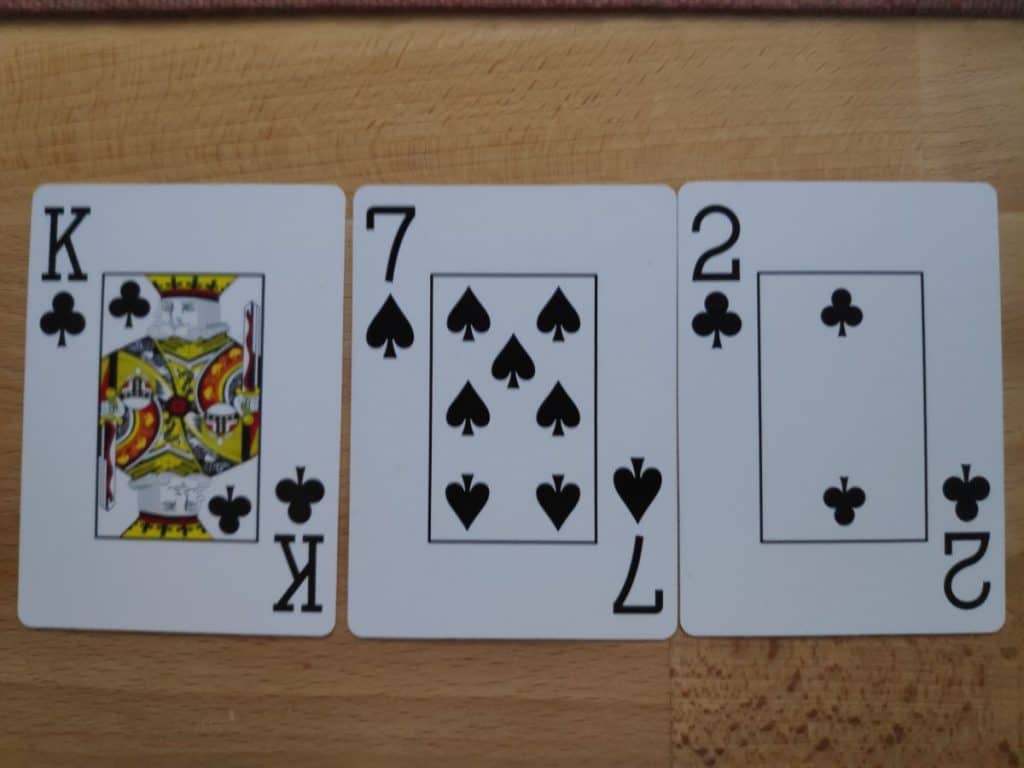
- Dry flop: Best boards to bluff on are the dry boards.
If the flop comes K52 or Q62 rainbow, for example, rest assured that a player that opened in the early position will try to make a continuation bet. Often the opponent will continue with aggression if a turn is another broadway card because it hits their pre-flop raising range.
Dry flop doesn’t have many draws present, and more often than not, if someone bets, then a person who holds a draw will fold, as there is nothing to draw to. - Drawing (wet) flop: Contrary to dry flop, a wet or draw heavy boards will have as the name suggests, many draws that can hit on turn and river.
Examples of this are Ts9s6c or JT7 flops. A person who bets on such flop will most likely have at least a decent draw. Betting as a pure bluff here will cost you a lot of money. Someone is far more likely to have some piece of the board on such flop than in the Q62 example. Even weaker players wouldn’t be bluffing a lot on this kind of board.
Bet sizing
The size of the bet can tell you a lot if the opponent is bluffing or he has a made hand. It is important to note than vs. an unknown player who you have no reads on yet you are better of giving him credit for a hand. When you see for the first time that he bluffed and he used out of the ordinary bet sizing, you should make a note of it.
Three different scenarios are quite popular at lower limits:
- The opponent usually bets around ⅔ of the pot for value, and now on the river, he goes for a pot bet. If the board has completed a flush draw or an obvious straight draw, then you should still give him credit for the strong hand. But if the majority of obvious draws have missed, he is likely to be bluffing.
- Contrary, if the villain bets close to the pot with his strong hands and now you see him betting only around half of the pot, then his hand is likely to be a bluff or a draw.
- The third option happens when you see someone min betting. In the majority of the cases, this is a weak hand, and if you put a lot of pressure on the opponent, he will fold often. For this one, you don’t need a read. Keep treating it as a weak hand until an opponent shows you a strong hand, and he went for a trap by min betting.
How fast an opponent bets
In online games, many non-pro players have a big leak when it comes to how fast they start betting when they have a hand. Their excitement gets the better of it, and together with a big sizing, they would go for a very fast if not instant bets. This doesn’t necessarily mean they have the nuts. They have what it looks in their eyes the best hand currently.
It is advisable that here you also get some reads first before assuming that fast bet is a made hand. Some of the players just automatically bet fast with anything. If you notice such behavior, you should note it, of course.
If you see them betting slower now, then most likely they don’t have the nuts, which you could exploit by reraising on the flop or turn with some blockers or a very strong draw.
How well does the board hit opponents range
How well does the board hit opponents range will determine if an opponent is more likely to bluff or less. This is especially true for thinking players. Newer players will completely disregard the board and how well it hits their range and will not be bluffing according to this. Thinking players and poker pros, however, will be more likely to bluff on board that hits them better.
But be careful here. If the board hits their range better, they will also have a hand more often than usual. This means you shouldn’t start hero calling all over the place. It means that if you hit some piece of the board but not super strong, you should consider continuing more often, as a player will be more likely to bluff. For this to work in practice, you would need to combine it with other notes and stats you have on the villain.
The more aggressive the poker player is, the more likely he is to bluff
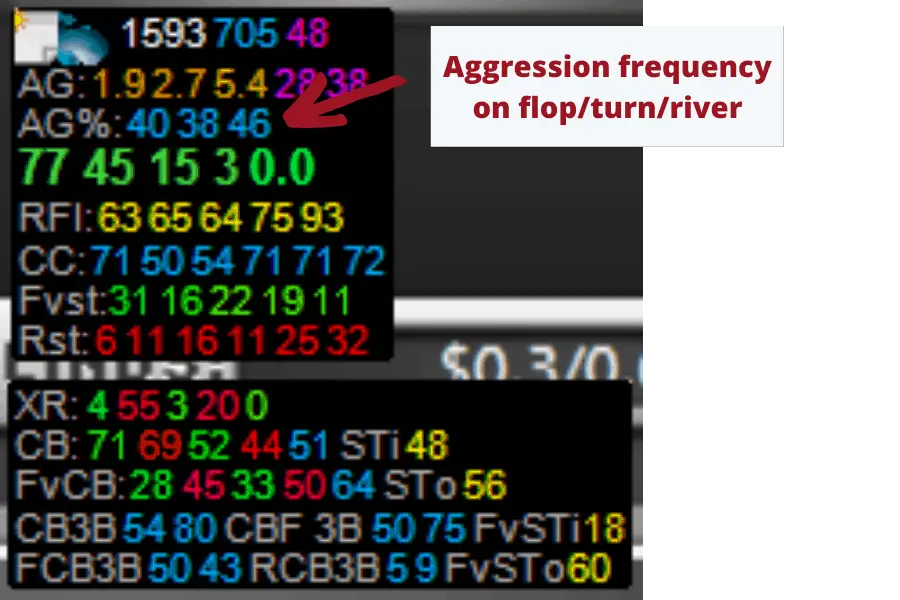
By paying attention to the table, you can see which player likes to 3bet more pre-flop and bet post-flop often. Moreover, such an aggressive player is more likely to bluff with a check/raise.
The thing to be careful about is if the opponent is a very tight player. Such player will have a solid hand often and will not be bluffing that much. So when you are looking at the HUD to see how aggressive a player is, it is vital to check for his VPIP and PFR stats also (how often he plays a hand and raises pre-flop).
Loose aggressive opponents will bluff more often
It comes down to math, really.
If an opponent has standard TAG stats, then he will sometimes be bluffing, but not as often as you might think. Regulars on lower limits won’t be bluffing often enough, so you are not making a mistake by giving them credit for the hand.
A loose and aggressive player, on the other hand, play differently:
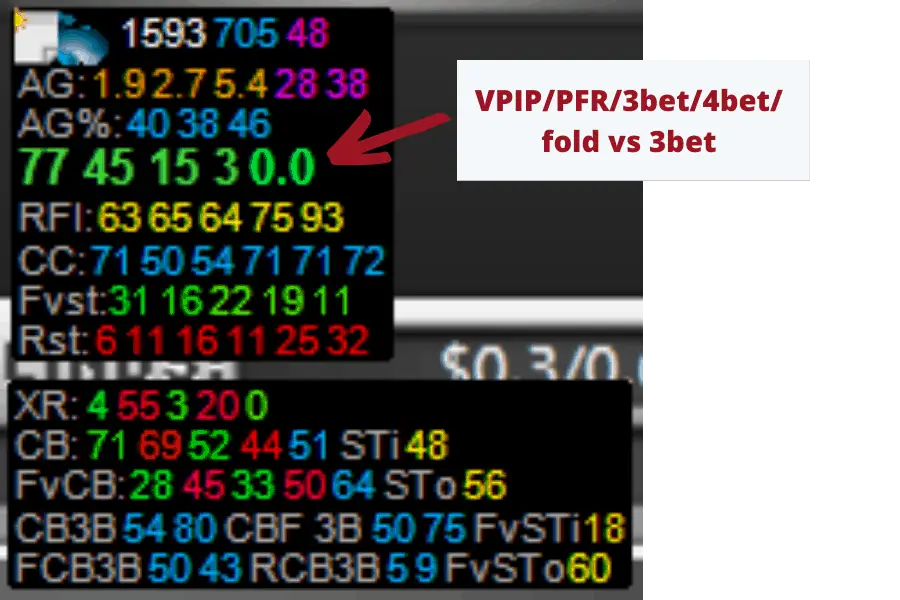
- They bluff often. They play too many hands, and therefore cannot have a strong hand that often.
- If such loose-aggressive opponent was to bet only when having a solid hand, then his bet would be quite low on the flop, around 30%. Quite contrary to that, such players often bet more than 75% post-flop.
- They can check-raise with weaker draws
- They need to be bluffing with gutshots, 3rd pairs. They will be firing on scare cards and overcards. Quite often, they will represent the nuts without having it.
- They can also value bet light, and this is opponent dependant
Frequency of betting can be enough to tell if a poker player is bluffing
HUDs can show a lot of information. One of them is the frequency of betting. Even more, these stats can show the frequency of bets in single raised and 3bet pots. You can make it show how often a player bets on the flop, turn, and river. That is why every poker pro uses a HUD.
Some players will have an exceptionally big percentage for a river bet. That is an excellent candidate to make a hero call against here and there. Usually, though, players might bet any flop, and then give up. If you play multiple tables, then this is hard to notice. But with a HUD, you can quickly see this from stats and make a correct decision next time when you are faced with a choice.
River bets of above 50% for regulars are on the high side already. Now imagine a player that plays double the number of hands, and he bets 70% of the time on the river after cbetting most flops and turns. Versus such guy you need to close the eyes and press call when you are holding semi-decent pair. Make sure that you have an adequate sample size first. 50 hands aren’t enough to pinpoint such river behavior.
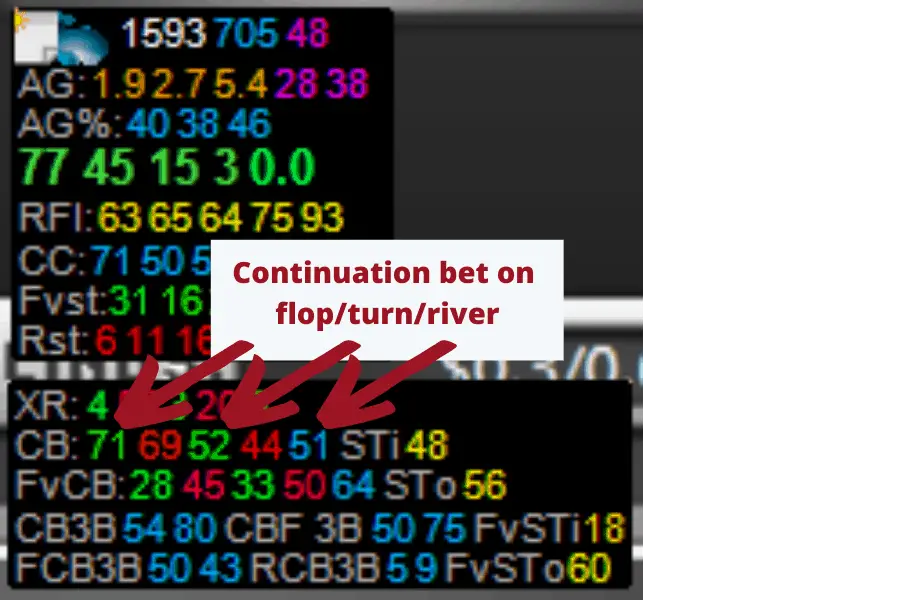
But once you have enough hands, such information can make you print money. It will be frustrating at times when an opponent will hit few draws in a row or backdoors. But you need to remain consistent in your strategy and keep making the optimal decision every time. If you follow your bankroll management, then you will do fine. You can lose a few buyins on bad days, but on other days you will finish a few buyins up if such players were to sit at your table.
How well does the board hit your pre-flop range
If you play poker, then I am sure you have encountered this. The opponent will be more likely to bluff if he knows that the board doesn’t hit your pre-flop playing range. The worse the board is for your range, the more likely the opponent will bluff.
For example, you open in an early position, and the button calls you. Flop comes 678. You check and the button will bet here the majority of the time. Buttons calling pre-flop range is wide, and your pre-flop opening range from early position is tight. Therefore you will often miss this flop. The opponent doesn’t need to have made hand here and can easily bluff you in this spot.
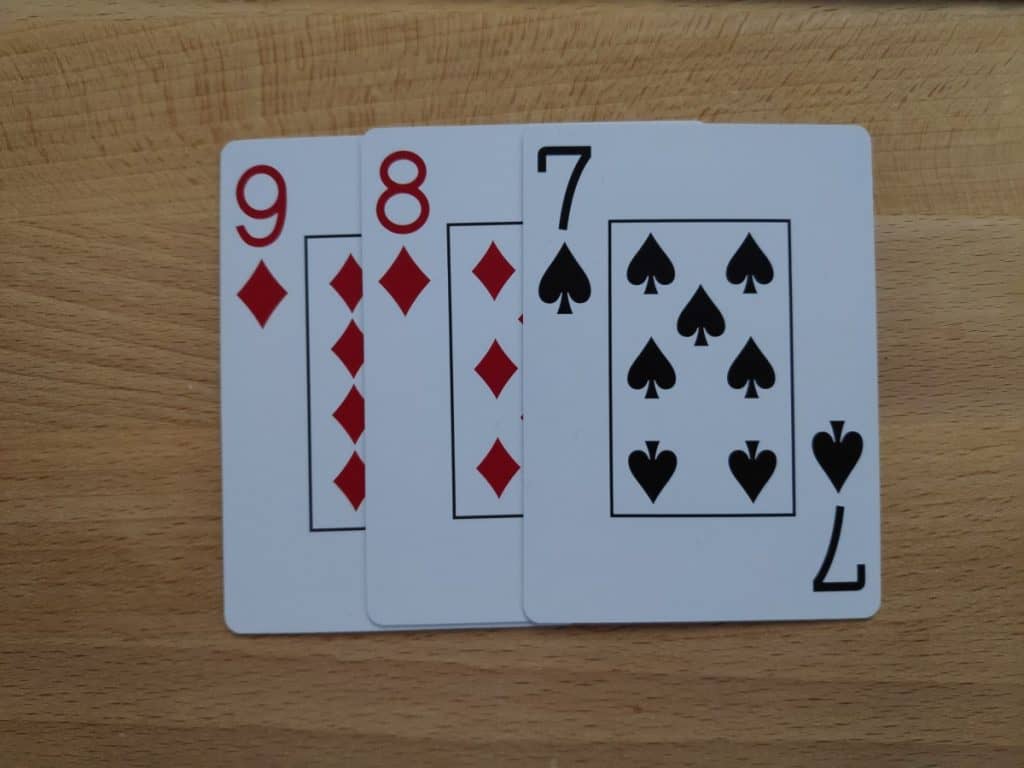
I need to mention you need to fold the majority of your hands here. It is not just about the flop, be rest assured any competent player will fire again on the turn and river. You don’t want to be a hero calling river with a naked pair here. So even if you know an opponent is likely to bluff you need to give up sometimes.
Spots like this, you should combat differently. In such a scenario, my flop cbet would be close to 0%. I would instead defend against bets with my made hands and semi-decent holdings by calling opponents bets. Let the opponent bet here and bluff if he wants, and just call him down with a solid hand. The majority of the times that you miss the board, just fold.
Stack size
If you play as a short stack, then opponents won’t be bluffing with check-raises over your bets. They will, however, be willing to stack off with a lighter value range. If before they needed at least top 2 pair to stack off against 100bb stack, then now top pair and decent kicker will be enough. They will not have pure bluffs.
If you play deep and the pot is still small, you can see some check-raises as bluffs from opponents. Also, they might be more likely to cbet on scary boards, as they know you don’t want to play a big pot unless you have a decent hand. I didn’t meet many opponents that would be bluffing with a huge river bet on the river when the pot is huge already.
Opponents will bluff on A high board

Even though everyone will fire one bet or maybe two on ace high boards, this doesn’t mean you can start hero calling. Again this kind of board depends hugely on opponent’s statistics. If he doesn’t bet a lot, then you can fold. If he bets a decent amount but is somewhat straightforward, then you can call one street with a lower pair. If you are up against an opponent that will value bet lightly, then you should fold. Such players might fire all three streets with a weak top pair and low kicker. The worst thing to do is to hero call him with Queens only to be shown A6 on the AJ923 board.
Playing against bets on A high boards is quite tricky; it is opponent dependant and requires some notes. You are better off just giving them credit for the ace in their hand all the time when you are just starting to play poker, and later when you have more experience, start widening your strategy.
The opponent on tilt will bluff a lot
If you are up against an opponent who lost a few big pots in a row against suckouts and coolers, then he might be on tilt. An opponent is on tilt if he starts betting fast, his bets are close to pot size, where before they weren’t, and you saw him stacking off lighter now. He might be even typing angry messages in the chatbox. All these actions would suggest the opponent is on tilt.
When someone is upset in poker, that is the best thing for you. Not only he will call you much lighter and not give you credit for the hand, but he will also be far more likely to bluff now.
During my poker career, I remember the cases when a super tight player would start playing like a spew monkey and would donate 3-4 buyins more with bluffing before finally leaving the table.
Conclusion
The factors above will be an excellent help to tell if the opponent is bluffing. But an important note here. No info and stats that you have on the opponent are bulletproof.
Even though the opponent is crazy, he bets all the time and is loose pre-flop, he has lost a few buyins already, and now he is betting again. Board doesn’t hit your range, but still, you have 2nd nuts. Now you are faced with a huge river bet, same of what he did before for a few times already and was caught bluffing. This doesn’t mean that now he will not have the hand. He can still have the nuts.
Every player will win the hand sometimes. If he has 15% to win the hand on the flop, then he will win 15% of the time in the long run if it gets to the river every time.
If you made the correct decision and were wrong, then just move on. If you are not sure that your choice was right, then mark the hand and move on. Review the hand later or post it on a poker forum like 2+2. Follow the proper bankroll management, and you will make nice money against such players in the long run.



